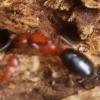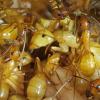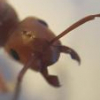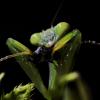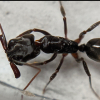Native bees have been struggling heavily lately. There is tons of money to fix honey bees when they start having issues. Mites, mold, etc. But none of that money is thrown at the native, wild bees that they inevitably spread disease to. They're all visiting the same flowers,flapping the same air in their wings, you get the idea.
Keeping a animal in captivity alters it. It might not be visible on the surface, but it could be as simple as feeding them a different diet than they get in the wild and altering their gut bacteria. If you care about the wild kin to the creature(s) you're keeping, don't release what creature(s) you've kept in captivity.
Native bees are struggling because - and that's a particular issue in the US - there are huge corporations driving THOUSANDS of bee colonies across the country all year long.
The ant equivalent of that would be someone driving huge Solenopsis invicta colonies all across the US letting them do their nuptial flights in any town they pass.
OF COURSE THIS IS BAD FOR LOCAL INSECT POPULATIONS because it's utterly ridiculous in the first place.
There's even studies that can trace the Varroa mite's path with surprising precision, the mites were actually introduced with IMPORTED bees, not with native bees from the corresponding area.
Honey bee companies spent DECADES spreading Varroa mites all over the world before they even realized the problem.
It's not even comparable with a few antkeepers releasing ants that are from their area anyway.
On the scale of ants, 1km is a massive, massive distance. Comparable to humans island hopping or even crossing oceans in certain cases. In a similar fashion to how 90% of Native Americans were killed by diseases from European settlers, you could be doing a similar (although probably not as severe) thing.
No, not really. Camponotus ants that grow to huge colonies can create satellite nests hundreds of meters away from their main settlement, Messor and Atta walk hundreds of meters to their feeding grounds and a lot of the semi-nomadic ants (Crazy ants, many Tampinoma and Solenopsis species) are traveling all over the place anyway. Even ants as mundane as Lasius niger are known to climb 5-level building because the heat on the roof makes their brood develop faster and they will not hessitate to invade homes when they find food either.
The comparison between native ants from the next town and settlers (or ants) from ANOTHER CONTINENT is nonsense. Ant alates by the way can drift for dozens of kilometers when they catch the right winds - for example they obviously can cross the street of Gibraltar as you'll find the same ant species on both sides of that channel (spiders and mosquitos are even more extreme, those can travel for hundreds of kilometers and are actually considered part of the "air plankton", swarming locusts can travel up to 300 kilometers per day).
To recap:
1. All animals are altered in some way by even coming into contact with humans
2. We don't know to what extent the animals are altered, or how those alterations could affect wild populations of said animal
3. These alterations to captive animals could harm wild populations or in some way change the ecosystem the previously captive animal is introduced to.
There is a reason why myrmecologists tell you not to release your ants, people.
Scientists will ALWAYS tell you not to release ANYTHING, it's become pretty much a tradition at this point. For them their test subjects are basically throw-away items. Also they often have other animals from several countries in their labs and there is actually a far higher chance of some cross-infection going on than in the home of a random guy only keeping species local to the area.
Considering the frequency at which ants invade houses and how they interact with each other (particularly in nuptial flights) their populations likely came into contact with anything that can be found in the average household anyway.
If we follow your logic to the last consequence we'd have to utterly purge any ant colony that chose to invade a trash bin because it alters their metabolsims in some way (which would be quite some effort in my city where there's a Lasius niger or Tetramorium colony under almost every public trash bin). Hell, there are even "fast food ants" in New York, specifically ants of the genus Pheidole that have started to revive their lost third worker caste (those ludicrously big-headed supermajors) due to the ridiculous intake of protein from fast food people throw away all the time.
We'd also have to lock up or murder any free-ranging cats because those are notorious long-distance travellers and will spread anything they came into contact with in their owner's house across dozens of kilometers and are in fact a member of the "top worst 100 invasive organisms on the planet" list being responsible for the complete eradication of around three dozens species of amphibians, reptiles, birds, and small mammals. Free ranging cats kill 1.4 to 3.7 billion birds and 6.9 to 20.7 billion mammals EVERY YEAR in the US alone.
Cats are actually the single largest threat to wildlife in the US. I'd be far more concerned about those and the stuff they spread around the envirnoment (they are often treated with chemicals so they don't get flea, worms or other parasites and they obviously spread those drugs around whenever they take a dump) than I'd be worried about a few native ants that came into contant with human households - something they frequently do anyway.
Your colony didn't have to battle the hardships of the outside world. There's no way of knowing if her genotype is fit to enough survive in the wild. Releasing alates might dilute wild populations and reduce genetic fitness.
Probably a small point but then again every queen counts in the fight against RIFA.
My personal opinion is why risk it? You don't gain much from releasing alates/colonies into the wild so better safe than sorry.
Um... NO. Evolution and genetics don't work that way.
If an ant survives in your formicarium her offspring are likely to survive in the wild as well, especially considering that if you release the alates they'll have to go through the trials of natural selection anway. The main reason colonies die after their release is because of a poor settlement location but the alates do not have this issue - they can choose a place on their own, like any wild ant alate can do.
There's really not too much of a problem with releasing ant alates as long as the colony is healthy, the species is native AND the colony's queen is from the local area (not the other end of the state or country).
I wouldn't encourage anyone to do it but particularly in the case of super abundant ants with massive nuptial flights (Lasius niger, Tetramorium, Iridomyrmex, Solenopsis fugax) it can't really hurt either.
Edited by Serafine, June 15 2019 - 1:01 PM.





